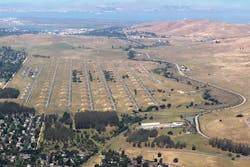An Otto driverless truck takes to the highway.
TM&E: Let’s begin with a progress update on how the partnering aspect of the GoMentum Station has been proceeding since your article from last year (see Driving Toward Connectedness in the Spring TM&E 2016 edition).
Randy Iwasaki: GoMentum Station is, as you know, a 5,000-acre former naval weapons station, featuring 20 miles of paved roadway; two 1,400-ft tunnels; curbs and gutters; sidewalks; railroad crossings; potholes; and a mini-city. It is the largest secure AV/CV test facility in the U.S. and is fast becoming the center of CV and AV research. We have a number of new partners. Honda, one of our marquee partners, is still testing its autonomous vehicle; they’re on the second generation of Acura RLX. They also have now outfitted Bunker City with a traffic light system, a controller and a dedicated short-range communications (DSRC) radio to begin testing V2I infrastructure. They have a number of cars running on a loop, testing the traffic controller connectedness via DSRC with the vehicle.
TM&E: How many vehicles are out there?
RI: Last time I was out there, I counted about seven vehicles, all on the loop. Have you been out to Bunker City?
TM&E: Not yet.
RI: Well, seen from a map, each bunker is separated by a street, north and south, 1.8 miles long, a series of them bisected by cross streets, forming a number of 90° intersections. Four intersections surround each bunker. It creates a grid pattern like that found in a city, and the vehicles run a loop within it. Honda’s testing the vehicles at varying speeds to monitor the communication through the DSRC radio.
The Bunker City testing grounds.
Otto Motors (a San Francisco-based startup) is testing out on the 8-mile-long spine road that runs along the city. There’s a YouTube video of one of their autonomous trucks delivering Budweiser. The commercial industry in the U.S. is about 30,000 drivers short, currently. Based on current regs for truck drivers, there are limits—eight hours, etc. And some of that gets lost in dwell time, so your average driver isn’t able to maximize his drive time. Well, with the autonomous mode, as it shows in the YouTube video, the driver puts on the AV mode and goes back into the sleeper, and the truck drives itself. It went from Fort Collins, Co., down I-25, through Denver, all the way to Colorado Springs. Once it gets close to the off-ramp, the driver disengages the AV mode and takes over.
So what you see is this giant shadow of influence growing, in terms of getting the most out of the drive time and addressing the shortage of drivers, which will be become more and more important as the population of the U.S. continues to grow. It’s a great opportunity. So Otto is testing at high speed on that spine road.
We have another partner in EasyMile. That’s our first- and last-mile solution; we’re calling it First and Last Miles, because generally it’s never just ‘a mile’, is it? You live in a city and you want to use your bus or rail system, but you live 2.2 miles away, well EasyMile solves your having to drive and try to park at a transit hub with limited parking or no available parking. We’ve brought two out to GoMentum Station, and we’re testing them there. These are fully autonomous. In California, we obtained legislation that exempts us from having to have a steering wheel, a brake pedal and an operator. This is the first legislation of its kind in the U.S.
If you look out into the future of technology, you won’t need an operator. Our legislation enables us to test at GoMentum Station, and at a business park, so we chose a place called Bishop Ranch. It’s a 600-acre business park in San Ramon, right along I-680. The beauty of the Ranch is that it’s home to GE, AT&T, Chevron . . .
TM&E: Lots of commuters.
RI: Lots of commuters. The owner of the Ranch has paid for express buses for 20 years. Well, presently it takes 30 minutes to get to the Ranch, 30 minutes to go through its rotation of dropping off passengers, and another 30 minutes to deadhead back with no passengers. Lots of lost time. So what we’re doing is helping the system operate more efficiently. It’s a great opportunity.
The EasyMile transport shuttle.
TM&E: How soon will testing get underway?
RI: The testing has started, we’re rolling it out. We’ve got a partnership with the Dublin Livermore Amador Valley Transit Authority. They’ve redesigned their entire service offering, but on curtailed routes people still need to get out to the BART stations. So instead of deadheading out of the Ranch, you can pick up those workers that want to go out to the BART stations and get them out. This will help cut down on the deadheading and all the cars coming in and parking. It’s good because I-680 is the fifth-worst commute in the Bay area and it’s only getting worse. With the economy in the area being so hot, you’ve got a lot of commuters, but with few options besides driving. We’re trying to make it more timely and convenient to not drive.
TM&E: Any other partners?
RI: We’ve got a few in the works, but we haven’t made the announcements yet. (As of press time, CCTA announced a partnership with BestMile to use its cloud-based computing platform to support the operation and optimization of AV fleets, including the full testing of EasyMile shuttles.) As of now, we’re pressing forward with the work at GoMentum. Once we go onto public roads, however, we’re going to have to get the autonomous shuttle vehicles permitted and that’s the next step. Can’t be on a public road without certain permits.
TM&E: Which is why Uber packed up its AV fleet and went to Arizona. They didn’t want the permits.
RI: Pretty much, yeah.
TM&E: What do you see in five to 10 years? Do you see this technology ‘hitting’ first in single-occupancy vehicles or in the transit sector? Where will the biggest impact be?
RI: I suppose my guess is as good as yours, but we’re looking at the future, certainly. We’re in the process of updating our 25-year county transportation plan. If you go to the National League of Cities and ask what percentage of major metropolitan cities are embedding AV/CV in their long-range planning, it’s something like 6%. We’re trying to embed that into our plan, as well as the idea that we’ll have a zero-emission fleet turnover, because California is concerned with greenhouse gases. We want to make sure we’re investing in the right technologies for the future. Instead of modeling for 2,000 vehicles per lane per hour, we’re modeling for 3,300, on the idea that connected and automated vehicles will allow cars to prevent crashes, and thus be able to follow closer. So then what do you need to do with your infrastructure? Do we need to widen our interstates, for example, in the future? Can we do with narrower lanes? And what about an AV-only lane? How much could that carry and how much would it alleviate congestion on the mixed-use lanes? Is it better to invest in traffic operation projects or infrastructure projects, when there’s a limited amount of funding at hand?
On the other side of it, if we can devise a better and more convenient way to get people onto transit, we may need more buses. Would they be operator driven or driverless? We’re trying to model that as well, for the future. This is why a solid, long-term plan is so crucial and why we’re building one. But we’re a long way out before much of the transit system—the rubber-tire transit system, anyway—is driverless. Consider this: BART was designed in the 1950s to be driverless, but we never got to that point. I see in the next five years a bigger roll-out of AVs, but I see it helping the transit industry first, in terms of aiding first/last-mile access to transit. In the near term, if this works, we may need more bus service.
An Acura RLX testing a pedestrian presence at GoMentum Station.
TM&E: And the automotive industry?
RI: I think they’ve got a ways to go to get a measure of safety, for example, in making a left-hand turn in front of oncoming vehicles. All those different maneuvers, making sure pedestrians and bicyclists are safe. It’s going to take a while on that. For now, however, we’re really excited about this first- and last-mile connectivity issue. It’s a real suburban problem, and we’re trying to solve it.
TM&E: How has the public opinion been shifting in Contra Costa County?
RI: We used to hold forums where we’d get maybe 40-50 people, or polls of a couple hundred viable responses. Well, recently we reached out to citizens through a variety of mediums, and we got something like 15,000 responses. That’s more than the entire previous two decades combined. A lot of it was ‘We hate those damn potholes’ or ‘Why do we have to stop at a red light when no one else is around, why aren’t the lights smarter’ and ‘We want a bigger, better BART.’ Or ‘I live in Antioch and can’t get to my transit stop, because I don’t drive and it’s too far for me to walk, can you help me?’ That last one reinforces our efforts on first and last mile. We want to provide service and mobility to the underserved areas of our county.
TM&E: Do you think programs like EasyMile will be important to general public buy-in on AVs? Because lots of folks still don’t get the value of AVs to the parts of the country where they live, or they’re too acclimated to how driving has always been to want to change or see the value in changing. Or to feel safe doing so.
RI: The ultimate test is whether a mother will let her child go into an AV by themselves. But one of the reasons we’re testing out at Bishop Ranch is that the owner there, Alex Mehran, is adamant about wanting to bring AVs to the public. He also wants to fully utilize the land he has, and he sees AVs as a way to help him get there. Not building more parking, for example. We need forward-thinking people like that to help us. That’s how we get to a future with zero auto fatalities.
TM&E: Anything else on the horizon?
RI: On March 30, we’re holding our third Redefining Mobility Summit in San Ramon. We’re going to have a slate of developers on one panel talking about how they’re going to accommodate the next generation of technology.



